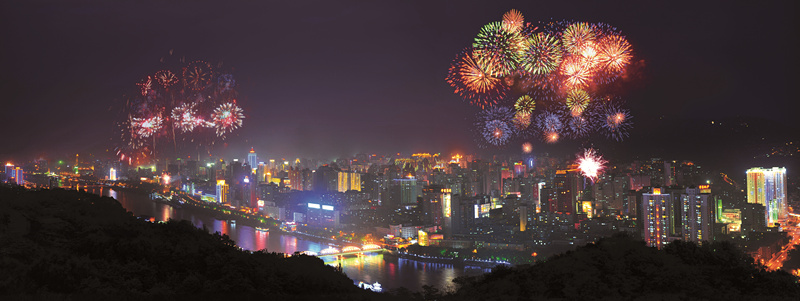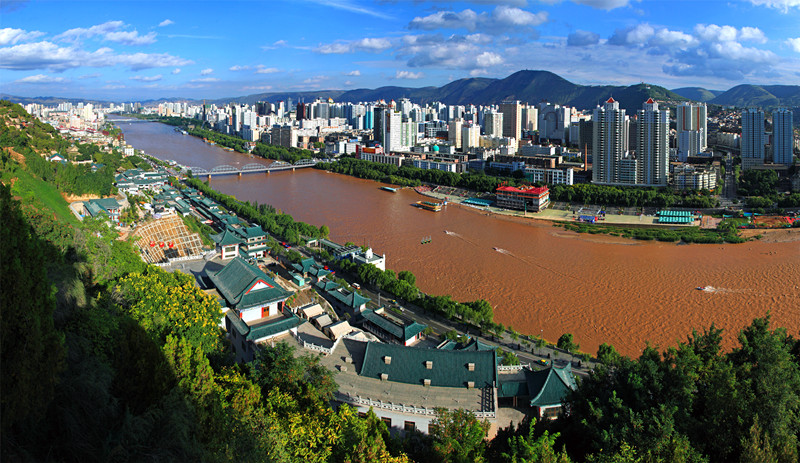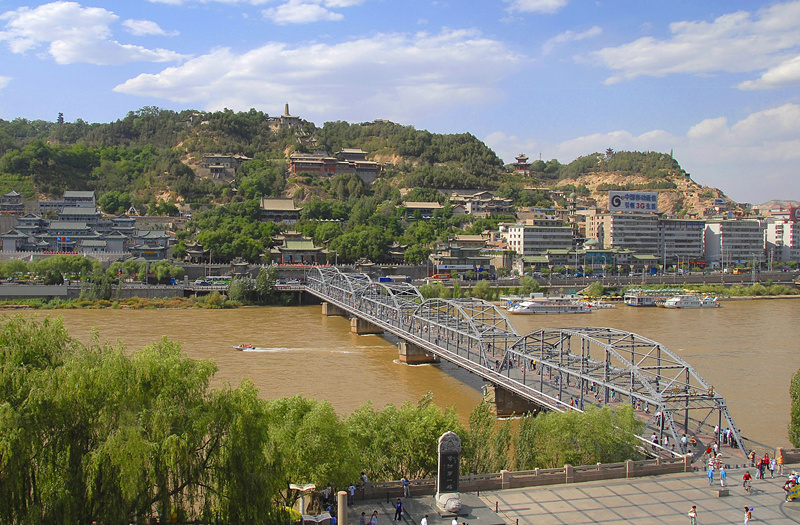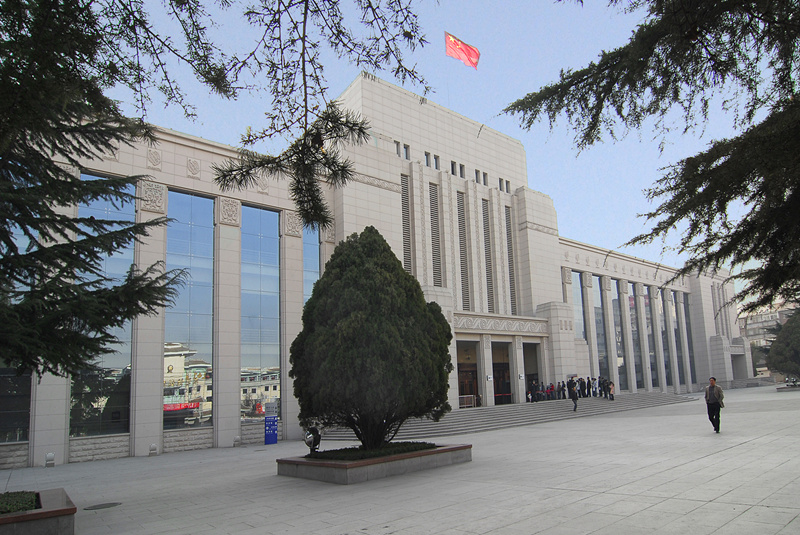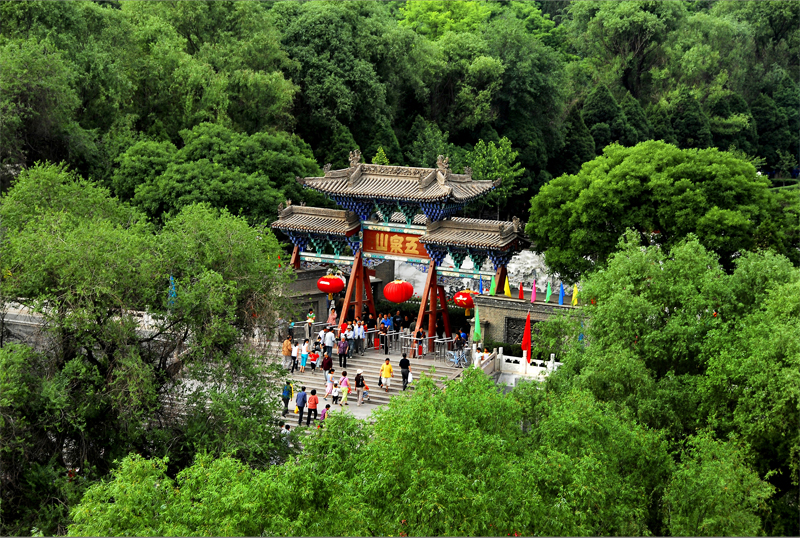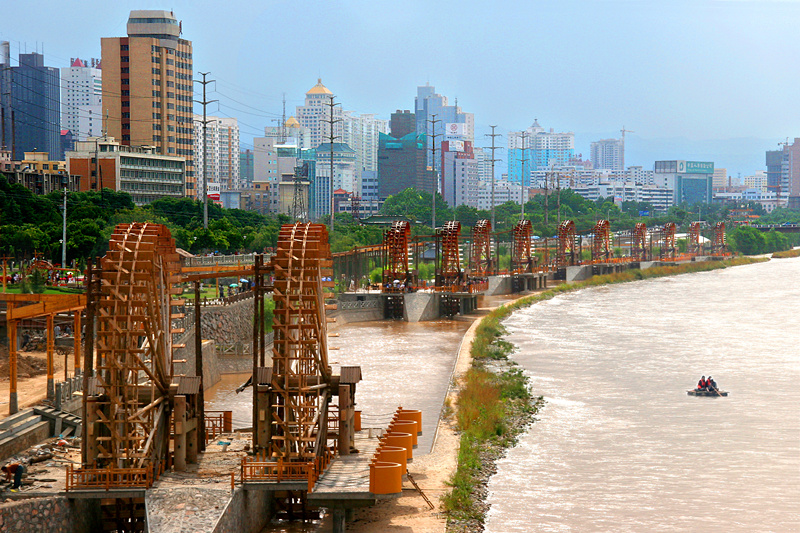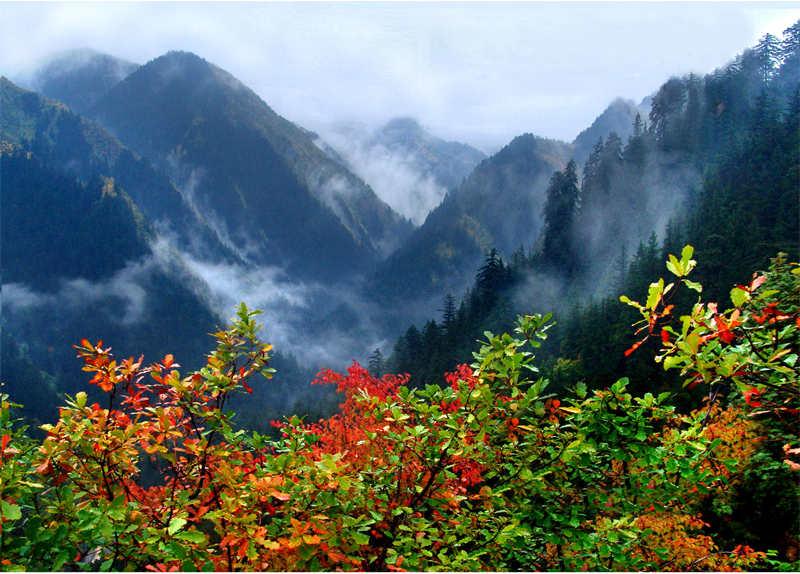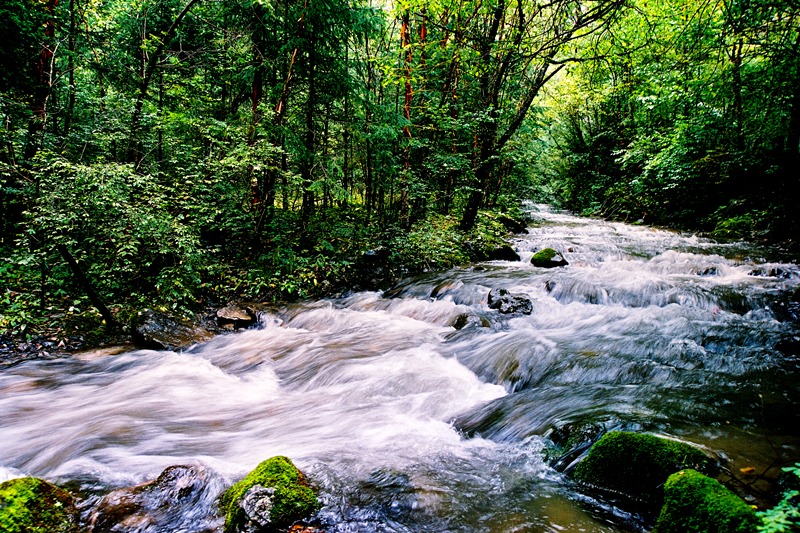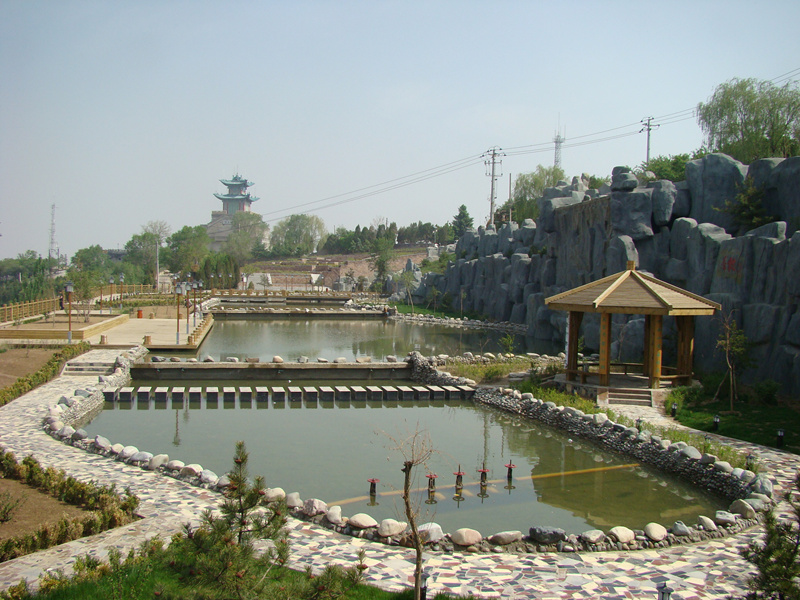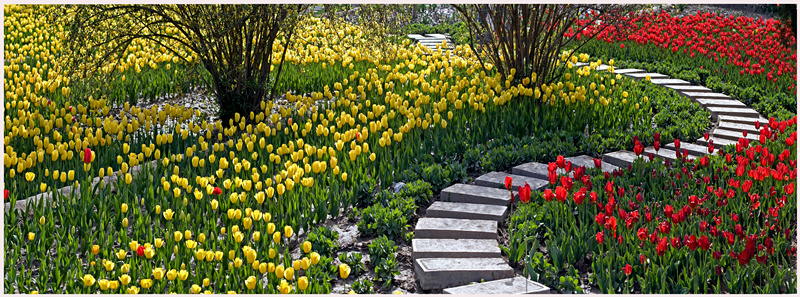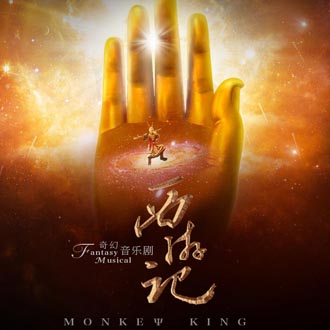Lanzhou City
Lanzhou, also known as Jincheng (Golden City) in history, is the capital city of Gansu Province. It is now in charge of three counties and five districts, the fifth new development area of China—Lanzhou New Area, two national development zones—Lanzhou High-tech Industrial Development Zone and Lanzhou Economic Zone and 4 provincial industrial zones. It covers an area of 13.1thousand square kilometers and its city proper area of 1631.6 square kilometers. The total population is 4.4 million, with an urban population of 3.616 million. And it enjoys the name as the Major City of the Silk Road, the Pearl of the Yellow River, the Summer Palace of the West, the Capital of Waterwheels, the City of Melons and Fruits. As a famous cultural tourist city in West China, Lanzhou enjoys a long history of over 2200 years. The prehistoric sites represented by the ancient Majiayao, Banshan, Machang, Qijia cultures are widely scattered in Lanzhou. The Silk Road culture, Yellow River culture, Folk culture and Ethnic culture enhance each other’s beauty here, displaying diverse regional cultural features and leaving many cultural and natural sites and historical relics for visitors to explore. The 50-kilometre Yellow River Park alongside the river is the biggest open river park in China, attracting more and more tourists both at home and abroad. The city also has scenic spots such as Five Springs Mountain, White Pagoda Mountain, Zhongshan Bridge, Waterwheel Park and the Mother Yellow River Sculpture. Other places of interests are Heavenly Palace by Sand Axes (Tianfu Shagong) featured with Danxia Landform, Mamenchisaurus Fossil Relic which is the home to the biggest dinosaur in Asia, the Majiayao colored pottery which represents the essence of Yellow River culture, and the Complex of Prince Su’s Tombs of Ming Dynasty. There is local Magistrate’s Office of the Ming Dynasty—Lutusi Yamen, the state-level key cultural relic. Xinglong Mountain, listed as “National Nature Reserve", Tulugou Valley, listed as “National Forest Park", are well renowned. In Gansu, the unearthed paper of the Han Dynasty and Pottery Drums are rarely seen in the world. You can also appreciate the national treasure Si Ku Quan Shu (The Complete Library in the Four Branches of Literature) from Wenshuge Academy. With a total collection of 18.2 thousand artifacts, there are more than 600 historical sites and cultural relics like White Pagoda Temple, Taihe Iron Bell and Temple of Bronze Ambassador Buddha. In recent years, the “Cultural Lanzhou" has attained remarkable achievements by creating a batch of masterpieces. Tales of the Silk Road has been acclaimed as a Chinese dancing classic in the 20th century and a milestone in China’s dance drama history. The new version of Tales of the Silk Road is listed in the top ten National Theatre Classics, receiving acclaim China’s Northwest tour starts from Lanzhou. Lanzhou, taking on a brand new look, welcomes visitors from all over the world. The Scenic Zones along the Yellow River
In Lanzhou, the Yellow River flows eastward like a dancing ribbon. Along with the natural landscapes and historic sites on The scenic zones along the Yellow River are also compared to the Bund of Shanghai. Its real beauty lies in harmonizing everything along both sides of the river -- the solid and primitively simple waterwheels, the Nation’s first iron bridge over the Yellow River, the flower beds, the carpet-like green land, the willow trees dancing in the breeze, the buildings shining with neon lights, or the city sculptures and statues displaying a profound, and rich culture represented by the Mother Yellow River sculpture. They all contribute to the unique charm of the scenic zones along the Yellow river, which integrates the Yellow River culture, the Silk Road culture and the Folk culture. Flowering for three seasons a year, and remaining green from January to December, the city is always beautiful. When the evening lights are lit and fountains are spraying along the banks, the scenic zones along the Yellow River appear even more lively and exquisite. As the river flows eastward in the night, it looks like the glowing Galaxy extending into the deep vista. Zhongshan Bridge
The Zhongshan Bridge is an iron bridge over the Yellow River; it is also named the First Bridge over the Yellow River. The Lanzhou Iron Bridge over the Yellow River, was built in 1907 with a length of 233.33 meters and a width of 7.5 meters. Taking the advice of Mr. Peng Yingjia, the Mayor of Lanzhou of the imperial Qing government, Shengyun, the Governor-general of Gansu Province,utilized over 9,375kg (300,000 Liang) of Silver from the national treasury. The contract was executed by a German company Telge & Schroeter, with an American, McLeod Mamboben and a German, Derek Gauss acting as technical directors. It was renamed as Zhongshan Bridge in 1942, in honor of Dr. Sun Yat-sen. Zhongshan Bridge is like an epic, keeping the historical changes of the city. It has been a lasting memory deeply carved in Lanzhou. Gansu Provincial Museum
Gansu Provincial Museum was built in 1956, capable of serving Multiple purposes. Its predecessor was Gansu Scientific and Educational Museum, built by the Sino-British Board of Boxer Indemnity in 1939. “The ancient Silk Road extends over 1600 kilometers, and the Yellow River Culture has survived 8000 years." With this unique historical inheritance, Gansu Provincial Museum currently has a collection of over 350,000 items, ranging from historical relics, both contemporary and modern, to ethnic relics, fossils and Zoological and plant specimens. Since its establishment, the museum has accumulated a collection of over 82,000 items through archeological excavation, collecting and donations, of which, over 3000 items are classified as top antiques, 16 items (sets) as national level antiques and over 720 items as first-class national antiques. The Bronze Galloping Horse, in particular, has been made the symbol of China Tourism.
The Five Springs Park is on the northern side of the Gaolan Mountains situated in the south of Lanzhou, at an altitude of over 1600 meters. It is a famous scenic attraction with more than 2000 years of history. What appeals to tourists are the five springs bubbling up in the park combined with the ancient Buddhist buildings. The temples are harmoniously connected with galleries and pavilions against the backdrop of the mountains. The park is filled with the green bushes and trees, creating a secluded and refined surrounding. Its name is derived from the five springs which are Sweet Spring, Scooping-Moon Spring, Fumbling-for-Offspring Spring, Beneficial Spring as well as Grateful Spring. A saying goes that in the 3rd year of Emperor Wu in the Han Dynasty (20 B.C.), when General Huo Qubing was going on an expedition to the west, he had his troops stationed here. When his soldiers felt very thirsty and tired, he struck the ground with his horsewhip in five places. Instantly, the five springs gushed out from underneath the ground. At present, the Bronze Ambassador Buddha and the Taihe Iron Bell are the top-two antiques of the park, which are classified as relics under national protection. The Waterwheels Park (AAAA)
The Waterwheels Park was built in 2005, to reproduce the picturesque scenes of many waterwheels along the Yellow River shores 50 years ago. Located at East Binhe Road on the south shore of Yellow River, the waterwheel theme park is composed of three parts, the Waterwheels Park, the Waterwheel Square and the Cultural Square. As the oldest water-lifting device for irrigation along the Yellow River, the waterwheels can be traced back to the Ming Dynasty, now having 400 years of history. Lanzhou waterwheel also has several other names, such as Heavenly Wheel, Dumping Wheel, Irrigating Wheel and Tiger Wheel. In 1523, a Lanzhou native Duan Xu saw many waterwheels used for drawing water up into the fields when he worked as an official in Yunnan Province. Sensing that the timber-keel structure was applicable in his hometown, he made a drawing of it and brought it back to Lanzhou. Returning home, he began to create The Waterwheels Park, as the theme park of waterwheels, has the largest variety and number in the world. Thanks to the skillful and unique craftsmanship the waterwheels are thus built, forceful and masculine. They fully deserve the title of the best representative of Chinese waterwheels Xinglong Mountain (AAAA)
Xinglong Mountain is 5 kilometers southwest of Yuzhong County of Lanzhou, and 60 kilometers away from Lanzhou. Its elevation is 2400 meters. As the ancient verse goes, “Xinglong Mountain is oftentimes covered with endless clouds." Therefore it was named Qiyun Mountain (Mt. Clouds Haunting). It has been known as one of the Scenic Attractions in Gansu and also honored as the First Mountain in the West of Gansu. Early in the West Zhou Dynasty (11 B.C. to 771 A.D.), the Taoist priests excavated caves in the mountain and cultivated themselves with spiritual practices. During the Tang and Song Dynasties (618 to 1276), there were prosperous shrines and temples where a large number of worshippers kept coming. The place was called the Paradise of Blessings. In the Qing Dynasty (1636 to 1912), there were numerous temples and pavilions with splendid paintings and glorious decorations, overhanging eaves and red pillars which face to the mountain or hide in the dense forest. However, most of the buildings have been destroyed, only the Yunlong Bridge across the Xinglong Gorge which was made during the Qing Dynasty survived. In the reign of Emperor Kangxi of the Qing Dynasty (1662 to 1722), the Xinglong Mountain was thus renamed, denoting revival. Since the 1950s, with 70 ancient temples, pavilions and 24 scenic spots scattered all over the mountain, Xinglong Mountain has revived as a resort of Buddhism and Taoism. Xinglong Mountain enjoys a mild and humid climate, with abundant biological resources in the forest. The most well-known characteristics are colorful flowers in spring, enjoyable trips in summer, golden scenery in autumn and distinctive chills in winter. Thanks to the magnificent and towering mountain, the graceful gorges and crystal spring water, and the enormous architectural wonders of the ageing temples and pavilions, Xionglong Mountain is renowned as “Grand Mountain in Gansu, Wonderful Scenery of Lanzhou". Tulugou National Forest Park (AAAA)
Tulugou National Forest Park is situated in Liancheng forest in Yongdeng County, Gansu province, and is the eastern branch of the Qilian Range, with an elevation ranging from 1998 to 3165 meters. This park is featured with the marvelous mountains and graceful rivers, and the tourism area is reputed as Mythic Green Valley. The word Tulu originated from the ancient Mongolian language, meaning the great and good things or the fruitful garden. Tulugou National Forest Park was a multi-ethnic community. Typical of the mountain climate, it has abundant rainfall. Having more than 1300 plant species, the forest areas reach 5800 hectares, verdant trees are all over the mountainous peaks and slopes. Located in the transitional zones of the Loess Plateau and the Tibetan Plateau, Tulugou National Forest Park has exceptional topography and the swiftly flowing Datong River is constantly nourishing this beautiful and miraculous land. The entire park can be divided into four major scenic zones, namely Front Tulugou National Forest Park, Small Tulugou National Forest Park, Sancha Tourist Village and Tulugou Amusement Pasture. The valley is secluded with the running river at the foot of mountain, flowers in full bloom at the bottom of valley, the dense bushes and meadows on top of the peaks, and a clear stream flowing dozens of kilometers. It makes an ideal destination for travel, vacation, picnicking, adventure, camping, sketching and science-exploration. Tulugou National Forest Park shares the merits of “the danger of Huashan Mountain, the grace of Mount Emei, the silence of Qingcheng, the miracle of Jiuzhaigou Valley". Lanshan Scenic Area (AAA)
Lanshan Scenic Area is located on the ridge of Gaolan Mountain which constitutes a natural city barrier at the south of Lanzhou. From east to west, the scenic area starts from Laolang Valley to Pibaling. This is the city’s first artificial forest park, thanks to the local people’s efforts. The park is built along the landscape of the mountain. Taking up an area of 346 hectares, the park’s low point is Piba Hill on the east side of Five Springs Mountain (Wuquan Mountain), while the highest point is Santaige Tower. On the Mountain ridge, there are numerous towers and pavilions strewn here and there, overhanging eaves and red pillars forming a harmonious view. They are ideal destinations in summer to fend off heat. Santaige Tower stands on top of Gaolan Mountain. The three-story tower has one pavilion on the top, grandly imposing. Looking down at the city, tourists can get a panorama of the Yellow River flowing eastward all through Lanzhou. The winding path leads you to the Amusement Park, and you can have fun with car racing, Eight-Diagram Puzzle , the Maze, Colorful Palace and Monsters’ Cave. Nearby the park, you can find a 4000-year-old ancient hominid site, a defense work of the Qing Dynasty and Yingpanling Battlefield of Lanzhou’s liberation. Lanzhou Botanical Park (AAA)
Lanzhou Botanical Park takes up 36.6 hectares, and it is a forest garden with luxuriant plants, such as Ginkgo biloba, Euonymus bungeanus and other precious species. In the garden, the research center covers an area of 3.5 hectares, including a 7000-square-meter flower greenhouse. As a main flower culturing base and research center in Lanzhou, it owns more than 100 species, more than 50 ornamental flowers, and 70 new varieties. At the same time Lanzhou Botanical Park plans to build Herbarium, Photo Studio and Scientists Sculptures, etc. This large open park is not only a rare plant cultivation center, but a recreational and leisure resort. |
Lanzhou City
December 21, 2016
VIEWED: 0
Recommended Products
see all-
Best of Central Europe
HKD 2370 + Book -
Cycle the Danube
HKD 1860 + Book
